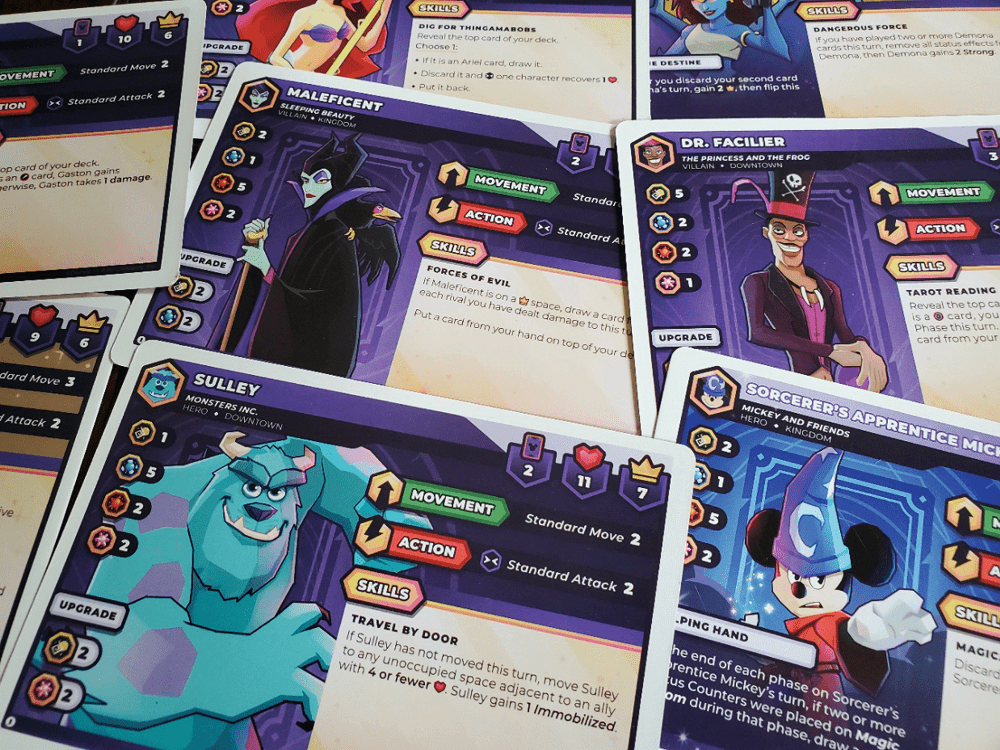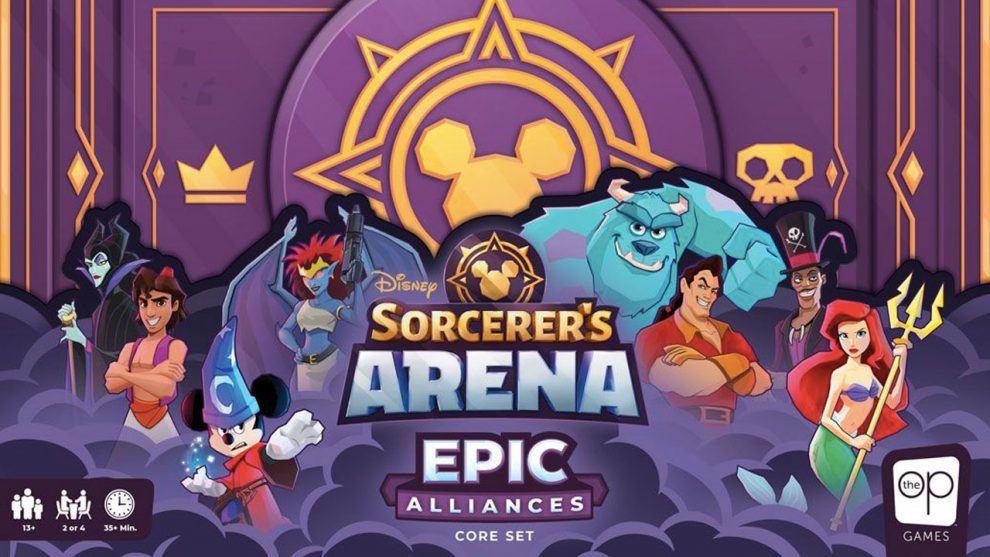For some reason, I have very fond childhood memories of Shrinky Dinks. Most likely, the memories stem from the fact that Shrinky Dinks. Are. Amazing. They might just be the best thing to come out of the 1970s. What’s not to love about taking a drawn, colored picture and tossing it in the oven for a minute or two and watching it curl and shrivel into a wee chunky keepsake?
One of the most nostalgic days I can remember as a parent is the day I found that Shrinky Dinks still exist. I had always assumed their magic was born of some toxic amalgam that had long since been banned from the public square—but there they were. Suddenly, all the hours spent with colored pencils and extreme heat came flooding over me and I was eight years old again. We’ve had them in the house ever since.
Imagine my surprise, then, when I opened the newest skirmish game from the Op to find acrylic standee characters not unlike the indomitable Shrinky Dinks. Where some might say, “Where are the minis?” I shouted, “Yes!!”

Disney Sorcerer’s Arena: Epic Alliances Core Set is a mouthful of a title, but that’s only because this battle royale from Sean Fletcher (Smash Up: Marvel Edition, Die Hard: The Nakatomi Heist) is brimming over with potential. Set in the Disney & Pixar universe, Epic Alliances is a team-up brawl that draws on a number of familiar characters and mechanisms to create a fascinating entry in the tabletop fighting genre. I like to think some sort of shorthand name will emerge as time rolls on, but throughout the review I’ll go with Sorcerer’s Arena.
Other games have tread these waters before. Funko has leveraged their collectibles into the Funkoverse series of releases. Restoration Games has had success with the ever-expanding Unmatched series. How will the Disney catalog hold up?
Chapter by Chapter
Before diving into the gameplay, I have to celebrate the easy approach and versatility of Sorcerer’s Arena. The rulebook is divided into four chapters, each introducing a mechanical layer to the game. At first glance, I wasn’t sure I would enjoy this approach to learning the ruleset. But as I invited my eight-year-old son to learn the game with me, I quickly witnessed the value of the time-release approach in a family setting.
While I believe older and more capable gamers can and should play the full four-chapter experience right out of the gate, the measured greeting is perfect for those who are either young or new to the skirmish genre. The first game scratches the surface with a 2v2 layout and roughly 50% of the battle mechanics. By the fourth game, the final 3v3 game is in effect, with every term and icon becoming second nature. The final pages then introduce the 4-player team concept.
The most beautiful aspect to this approach is that the game quickly reveals its inward parts, allowing players to settle into the iteration that suits their interest and their moment. Families with young kiddos might choose to stay in Chapter One or Two. Folks interested in a quicker game might revert to a 2v2 battle or a faster endgame trigger. Seasoned veterans may end up enjoying Chapter Three without the attentive hassle of Chapter Four. The variety within the system is cohesive and lends itself to creativity—a testimony to the game’s simple yet effective design.
For the purpose of the review, I’ll be looking at all four chapters fully employed.
Come inside, it’s fun inside
The Arena is a rectangular board of hex spaces with a set of five starting spaces at each end and three golden spaces across the middle.
Each character in Sorcerer’s Arena comes with an Ability card and a deck of ten Character cards. Once players—or Summoners—have chosen their teams of three, the decks are combined and shuffled. Each Summoner’s hand size is determined according to the Abilities of the selected characters.
Summoners then choose the order in which their characters will engage by organizing their Turn Order tokens and comparing them to the other team. Each Turn Order token has a printed value and the Summoner that places the lowest value in the first position will be first overall. The tokens are then lined up alongside the Arena board in alternating order.

The actual battle in Sorcerer’s Arena is similar to every other skirmish/fighting game you’ve ever played before. Character turns consist of three phases performed in any order. For the Movement and Action phases, Summoners may either adopt the standard value—most often two—or play a card which will include a bonus effect of some sort. The third phase includes the option of exercising a Skill unique to the character.
What sets Sorcerer’s Arena apart are the quirks. For example, there is no defense in this battle royale. There are Status effects that can provide very (very) limited defensive help, but nearly every attack lands a hit, making the action all about tactical setup and the execution of combos.
In this defenseless universe, characters are merely KO’d when they reach their damage limit. Shrinky Dinks are removed from the Arena and spawn again in one of the board’s starting spaces at the outset of the character’s next turn.
The aforementioned Status effects are lingering blessings and curses that can be assigned to characters. Immobilize. Tough. Strong. Stealthy. Magic Broom. When activated, each effect places a nested token alongside a character’s Turn Order token indicating the change. With each passing turn, the effect fades, eventually restoring the character to normalcy. These little buggers create a constantly changing landscape.

Those golden spaces in the center are Victory point spaces that provide passive Victory income to any character standing there at the beginning of their turn. In a game whose end triggers at 20 Victory points, these little treasure troves produce a King of the Mountain effect throughout the game as characters race to rake in easy rewards and fight hard to eliminate anyone in the way.
Chapter four introduces character upgrades, the most convoluted of the quirks in Sorcerer’s Arena. Each Character card features one of four icons in the lower right corner. As cards are played and/or discarded, Summoners may discard specific combinations of icons in order to upgrade characters. Each upgrade increases the possibility for deeper battle combos.
Play continues rhythmically until the point threshold is crossed. Once the end is triggered, the current round is played out and the Summoner with the most Victory points wins.

Should Gaston really fear Mickey?
In short, yes. Mickey is one tough rodent. But to be fair, this isn’t Mickey Mouse Clubhouse Mickey, this is Sorcerer’s Apprentice Mickey. Overall, Sorcerer’s Arena is rather well balanced. Each character boasts several unique qualities that are highly thematic and grow even more interesting, depending on the combination of characters belonging to a given Summoner. Just as each character turn is all about the combo, so too with the Summoner team.
Sully, as an example, has one of my favorite Status effects, the Taunt. When our favorite blue monster takes up the Taunt, rival characters cannot directly attack the other members of Sully’s team. Being the consummate good friend, Sully draws all would-be attackers to himself, allowing his mates to hit those Victory hexes to rake in the points while he swings those massive paws about. If he happens to team up with Maleficent, whose attacks are stronger on those precious golden spaces, the combo just works.
The eight stock characters are loads of fun. I don’t know The Princess and the Frog as well, but Dr. Facilier became a quick hit with my son. Likewise, Gargoyles isn’t in our top ten from Disney & Pixar, but Demona is rock solid. Aladdin, Gaston, Ariel, Mickey, Sully, and Maleficent are a nice intro to this world of Epic Alliances. The first expansion pack is already on the horizon with Stitch, Moana, and Davey Jones. You can see where this is going. We’ll all be swimming in Shrinky Dinks before we can say Zip-a-dee-doo-dah!

(Defensively clutches wallet)
The most obvious strength of Sorcerer’s Arena is Disney’s bottomless intellectual property. My four-year-old daughter wants to play with the game because Ariel is there. And when she saw the cover image for the expansion pack, she wanted to play with that one too. Disney & Pixar cover ample creative ground to keep this system active for—ever.
In a world of lucrative mini figures, though, I am impressed that Disney committed to the Shrinky Dinks under the pressure of this obvious gold mine. Truth be told, I find the acrylic standees refreshing. They are colorfully printed front and back with, well, a front and a back. Simple, but charming. They are cute and they serve the game system well. Minis, while impressive, could feel a little bloated given the playful nature of this universe.
My only complaint about the standees is the marker that attaches to the base to track character health. It feels like the flimsy ring that peels away when you open a jug of milk. In fact, my wife nearly threw one in the trash when we left it out because it was the same color as the plastic on our 2%. Several times during play, they popped free, forcing us to lean on our semi-reliable memories. That minor annoyance aside, I am a fan of the modest production value of the characters.

The rest of the components are fun, but the undoubtedly astronomical cost of the Disney name limits the production. The box is pretty lightweight. The insert is generic. The cards are merely adequate. The cardboard is cardboard. The nested Status tokens are my favorite feature of the bunch—a clever means of tracking the game situation. The pump is primed to focus on getting a wider array of characters in consumer hands rather than creating a collector’s environment. The character choices for the Core Set and the first expansion create the expectation of borderline-random and diverse sets in the future. But that’s what you want in this Arena.
Which brings us back to the fighting system. Sorcerer’s Arena is a game to be played, and it is fun! The full four-chapter experience plays in under an hour, and I’d imagine it will get faster and faster with increased familiarity with the characters and the combos. With six characters locked in fisticuffs on the board, there is enough going on to hold everyone’s attention, not to mention the geographic concern for those golden spaces. The final round or two will snowball into an avalanche of knockouts as gravity rolls the battle to its conclusion. We had a blast.
The final pages of the rulebook introduce the four-player option in which the full eight characters take to the map in two teams of four. The only change to gameplay is all the downtime of waiting for three other Summoners to take their turn. As a Core Set, Sorcerer’s Arena shines with two players. Once the depth of the Disney roster is released and families just can’t decide between Mary Poppins and Chick Hicks and who gets to play, I could see the four-player outing as a way of embracing the madness of 97 available characters. Even then, like most fighting games, the Arena will likely shine most brightly for two.
There’s a lot to celebrate in this Arena. Fans of Disney and the fighting genre will find a welcome and welcoming blend of proven mechanics, happy quirks, and familiar faces that equal loads of potential to entertain for years to come. Brace your wallet and enjoy the ride.













Add Comment